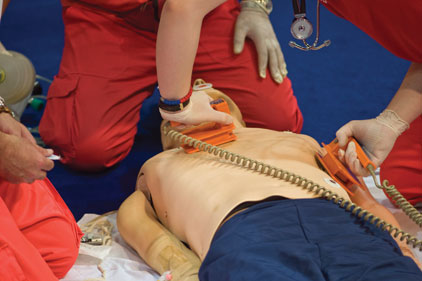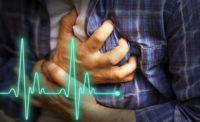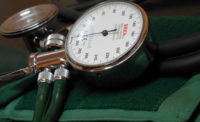“Tom” is hypothetical, but there are approximately 200,000 very real Americans who suffer sudden cardiac arrest (SCA) each year. If this were an actual medical emergency – with a real victim – would Tom be one of the 25,000 people who die annually from SCA?
The answer to that question may depend upon whether or not your worksite has an automated external defibrillator (AED) program in place. An AED is an electronic device that delivers an electric shock to someone who has suffered SCA or whose heart is beating irregularly.
Why not just call 9-1-1?
An AED provides the advantage of immediacy. The American Heart Association (AHA) notes that cardiac arrest is reversible in most victims if it’s treated within a few minutes. Summoning emergency medical personnel when someone suffers SCA is vital, but waiting for them to arrive reduces the victim’s chances of survival to only 5 to 7 percent.
The AMA points out that EMS responders can be delayed by heavy traffic, secured buildings, large complexes and high rises — conditions which contribute to a national average response time of 10 to 12 minutes. “Even the best EMS responders may have difficulty arriving in the first 3 to 5 minutes, when the chance of successful defibrillation is the greatest. The problem isn’t whether cardiac arrest can be reversed but reaching the victim in time to do so.”1
OSHA estimates that 60 percent of the 1,837 U.S. workers who died on the job in 2001-02 from heart attacks, electric shock and asphyxia could have been saved if AEDs had been immediately available.2
What causes SCA?
Cardiac arrest occurs when the heart’s electrical activity becomes disrupted, causing it to beat irregularly (ventricular fibrillation) or to stop beating altogether. In either case, the heart cannot adequately pump blood to the brain and other vital organs. Often defibrillation is the only way to restore the heart’s normal rhythm — particularly with ventricular fibrillation.
Can someone with no medical training use an AED?
Learning to use an AED is “highly intuitive and surprisingly simple,” according to The National Center for Early Defibrillation (NCED).”3
Dr. Monica Kleinman, Chair of the AHA’s Emergency Cardiovascular Care Committee, says that AEDs “are designed for use by anyone, including ‘lay rescuers’ — people who do not have formal training in AED use.”
Dr. Kleinman points out that AEDs have clearly numbered steps to follow and provide verbal directions to the user. “Depending on the model, there may be visual cues such as flashing lights to direct the user how to deliver a shock.”
Those who do receive AED training will likely take a four-hour course that also teaches cardiopulmonary resuscitation (CPR) and allows ample time for hands-on practice. Training is offered through the American Heart Association, the American Red Cross, EMP America and AED manufacturers.
Where should an AED be placed?
OSHA’s guidelines4 call for AEDs to be installed:
- in locations that ensure no more than a 3-5 minute response
- in areas where many people work or congregate closely together, such as assembly lines and cafeterias
- near confined spaces and areas where electric-powered devices are used
- at outdoor worksites where lightning may occur
- in health units where workers may seek treatment for heart attack symptoms
- at remote sites, such as off-shore drilling rigs, construction projects, marine vessels, power transmission lines, and energy pipe lines.
Seven steps to save a life3
If you are the person responding to Tom Walcott’s medical emergency, here are the steps you should take:
Step 1: Establish that Tom is unresponsive. “People in cardiac arrest typically have no signs of life — they are unconscious and not breathing or not breathing normally,” says Dr. Kleinman. “Someone who has just had a cardiac arrest may make some gasps that look and sound very abnormal — that person should be treated as though he or she is in cardiac arrest.”
Step 2. Call 9-1-1 right away.
Step 3. Open Tom’s airway and check for breathing. If there is no breathing or breathing appears abnormal, give two slow breaths. When the heart stops, even though there is no circulation, the victim may continue ineffective breathing motions.
Step 4. Check for a pulse. If there is no pulse, turn on the AED. If someone is assisting you, he or she should continue CPR while you turn on the AED and attach the pads, in order to provide some blood flow to the brain and heart.
Step 5: Attach the AED electrode pads. Remove the adhesive AED electrode pads from the package and attach one to the upper right area and one to the lower left area of Tom’s bare chest. Correct placement enables the electric current to pass through the heart.
Step 6: Analyze the heart rhythm. Some AEDs analyze the heart rhythm automatically. Other models prompt you to press the analyze button. Follow the AED’s prompt and call out, “Analyzing rhythm, stand clear!” If the AED indicates that a shock is advised, go to Step 7.
Note: A study published in Circulation, the AHA journal, found cardiac arrest victims’ odds for survival rise significantly if rescuers pause CPR for less than 10 seconds before delivering an electric shock via a defibrillator.
If the AED indicates that Tom does not need to be shocked, check his pulse again. If there is no pulse, do CPR for one minute, advise onlookers to stand clear and analyze again. Repeat this sequence of CPR and analysis every minute until help arrives.
Step 7: Press the “shock” button, if advised. Make sure no one is touching the victim.
Call out, “Shock indicated. Stand clear,” then, press the shock button. Sometimes, the victim will be revived after just one shock. After the first shock is delivered, immediately analyze again. The AED will advise you if subsequent shocks are needed (and deliver appropriate energy levels for each shock). Continue the pattern of one minute of CPR followed by heart rhythm analysis and appropriate shocks until emergency responders arrive.
If you respond quickly and follow the procedures you learned in AED training, you have an excellent chance of saving the life of someone who suffers SCA.
2. http://www.osha.gov/SLTC/aed/index.html
3. http://www.early-defib.org/03_06_08.html
4. http://www.osha.gov/Publications/osha3185.pdf
sidebar:
CPR revisions
An essential part of the AED process, Cardiopulmonary Resuscitation (CPR) has evolved since its first implementation in 1740, when the Paris Academy of Sciences officially recommended mouth-to-mouth resuscitation for drowning victims (chest compressions weren’t added until the late 19th century).
For many years the American Heart Association (AHA) taught CPR steps in the following order:
• Airway (opened with a head tilt and chin lift)
• Breathing (assisted by mouth-to-mouth resuscitation)
• Compressions (performed about a hundred times a minute)
The AHA recently revised those guidelines to C-A-B, based on studies showing that starting chest compressions right away helped keep blood circulating and yielded better outcomes. About that one-hundred-times-a-minute compression rate: it’s the same rhythm as the beat of the BeeGee’s aptly-titled song, “Stayin’ Alive.”
The revision is a part of the 2010 emergency cardiovascular care report published by the AHA, which reviews its guidelines every five years based on new science and literature.
CPR training is available from a variety of sources, including the American Red Cross and the AHA, which trains more than 12 million people in CPR annually, including healthcare professionals and the general public.






